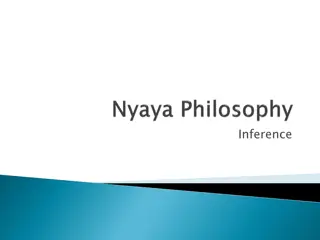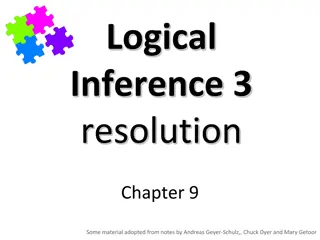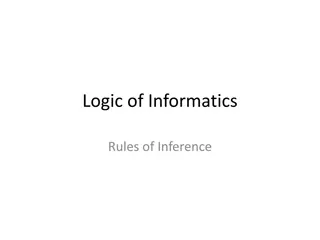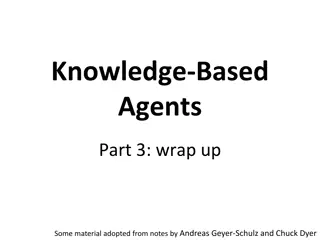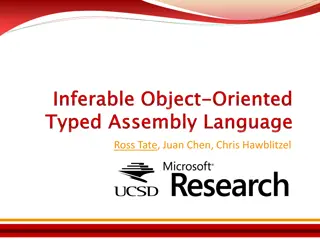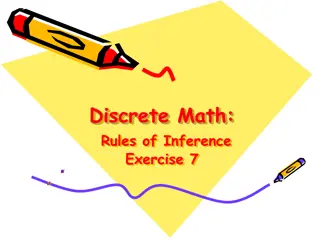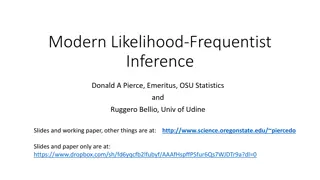Comparing Population Means: Inference Study
This chapter delves into comparing two population means using various statistical models such as independent sampling and dependent sampling. It covers methods like the two-sample Z-test, pooled variance t-test, and unequal variances t-test. Additionally, it discusses the concept of a random variable for the difference of two population means and presents an example hypothesis test on home sizes with and without pools.
Uploaded on Oct 01, 2024 | 3 Views
Download Presentation

Please find below an Image/Link to download the presentation.
The content on the website is provided AS IS for your information and personal use only. It may not be sold, licensed, or shared on other websites without obtaining consent from the author.If you encounter any issues during the download, it is possible that the publisher has removed the file from their server.
You are allowed to download the files provided on this website for personal or commercial use, subject to the condition that they are used lawfully. All files are the property of their respective owners.
The content on the website is provided AS IS for your information and personal use only. It may not be sold, licensed, or shared on other websites without obtaining consent from the author.
E N D
Presentation Transcript
Inferential Statistics and Probability a Holistic Approach Chapter 10 Two Population Inference Creative Commons License This Course Material by Maurice Geraghty is licensed under a Creative Commons Attribution-ShareAlike 4.0 International License. Conditions for use are shown here: https://creativecommons.org/licenses/by-sa/4.0/ 1
Comparing two population means Four models Independent Sampling Known population variances Two sample Z - test The 2 population variances are equal Pooled variance t-test The 2 population variances are unequal t-test for unequal variances Dependent Sampling Matched Pairs t-test 2
Difference of Two Population means is Random Variable 2 1 X X is a point estimator for 2 1 X X The standard deviation is given by the formula 2 2 + 1 2 n n 1 2 If n1 and n2 are sufficiently large, follows a normal distribution. 5
Difference between two means known population variances If both 1 and 2 are known and the two populations are independently selected, this test can be run. Test Statistic: ( ) ( X X Z + ) = 1 2 1 2 2 1 2 2 n n 1 2 6
Example 1 Are larger houses more likely to have pools? The housing data square footage (size) was split into two groups by pool (Y/N). Test the hypothesis that the homes with pools have more square feet than the homes without pools. Let = .01 7
10-13 EXAMPLE 1 - Design : : : H H H 1 2 1 2 o a : 0 0 H 1 2 1 2 o a = = + ( ) /( / / ) Z X X n n 1 2 1 1 2 2 H0 is rejected if Z>2.326 8
EXAMPLE 1 Data Population 1 Size with pool Population 2 Size without pool Sample size = 130 Sample size = 95 Sample mean = 26.25 Sample mean = 23.04 Pop Std Dev = 6.93 Pop Std Dev = 4.55 9
EXAMPLE 1 DATA ( 26 25 . 23 04 . ) 0 = = . 4 19 Z 2 2 . 6 93 . 4 55 + 130 95 Decision: Reject Ho Conclusion: Homes with pools have more mean square footage. 10
EXAMPLE 1 p-value method Using Technology Reject Ho if the p-value < Sq ft with pool Sq ft no pool Mean 26.25 23.04 Std Dev 6.93 4.55 Observations Hypothesized Mean Difference 130 95 0 Z 4.19 p-value 0.0000137 11
10-10 Pooled variance t-test To conduct this test, three assumptions are required: The populations must be normally or approximately normally distributed (or central limit theorem must apply). The sampling of populations must be independent. The population variances must be equal. 13
10-11 Pooled Sample Variance and Test Statistic Pooled Sample Variance: + 2 2 ( 1 ) ( 1 ) n s n s = 1 1 + 2 2 2 s p 2 n n 1 2 Test Statistic: ( ) ( ) X X = 1 2 1 2 t 1 n 1 n + s p 1 2 = + 2 df n n 1 2 14
10-12 EXAMPLE 2 A recent EPA study compared the highway fuel economy of domestic and imported passenger cars. A sample of 12 imported cars revealed a mean of 35.76 mpg with a standard deviation of 3.86. A sample of 15 domestic cars revealed a mean of 33.59 mpg with a standard deviation of 2.16 mpg. At the .05 significance level can the EPA conclude that the mpg is higher on the imported cars? (Let subscript 2 be associated with domestic cars.) 15
10-13 EXAMPLE 2 critical value method : : H H : : = : : H0 is rejected if t>1.708, df=25 : t=1.85 H0 is rejected. Imports have a higher mean mpg than domestic cars. 1 2 1 2 o a = / 1 + ( ) /( / 1 ) t X X s n n 1 2 1 2 p 16
t-test when variances are not equal. ( ) ( ) X X = 1 2 s 1 2 t Test statistic: 2 1 2 2 s + n n 1 2 2 2 1 2 2 s s n 2 2 n + n n = 1 2 s df Degrees of freedom: ( ) ) ( ) ) 1 2 2 2 1 n s n + 1 2 ( ( 1 1 2 This test (also known as the Welch-Aspin Test) has less power then the prior test and should only be used when it is clear the population variances are different. 17
10-13 EXAMPLE 2 : : H H : : = : t test : H0 is rejected if t>1.746, df=16 : t =1.74 H0 is not rejected. There is insufficient sample evidence to claim a higher mpg on the imported cars. 1 2 1 2 o a 18
Using Technology Decision Rule: Reject Ho if pvalue< Megastat: Compare Two Independent Groups Use Equal Variance or Unequal Variance Test Use Original Data or Summarized Data domestic 29.8 33.3 34.7 37.4 34.4 32.7 30.2 36.2 35.5 34.6 33.2 35.1 33.6 31.3 31.9 39.0 35.1 39.1 32.2 35.6 35.5 40.8 34.7 33.2 29.4 42.3 32.2 import 19
Pooled Variance t-test Minitab output p-value = 0.038 p-value < = .05 Reject Ho 20
Unequal Variances t-test Minitab output p-value = 0.051 p-value < = .05 Fail to Reject Ho 21
10-14 Hypothesis Testing - Paired Observations Independent samples are samples that are not related in any way. Dependent samples are samples that are paired or related in some fashion. For example, if you wished to buy a car you would look at the same car at two (or more) different dealerships and compare the prices. Use the following test when the samples are dependent: 22
10-15 Hypothesis Testing Involving Paired Observations X = d d t s n d where is the average of the differences is the standard deviation of the differences n is the number of pairs (differences) X d sd 23
10-16 EXAMPLE 3 An independent testing agency is comparing the daily rental cost for renting a compact car from Hertz and Avis. A random sample of 15 cities is obtained and the following rental information obtained. At the .05 significance level can the testing agency conclude that there is a difference in the rental charged? 24
Example 3 continued Data for Hertz = s 46 67 . X 1 = . 5 23 1 Data for Avis = 44 . 87 X 2 = . 5 62 s 2 25
Example 3 - continued By taking the difference of each pair, variability (measured by standard deviation) is reduced. = . 1 = 80 X d . 2 513 s d = 15 n 26
10-18 EXAMPLE 3 continued = : 0 : 0 H H = Matched pairs t test, df=14 H0 is rejected if t<-2.145 or t>2.145 Reject H0. There is a difference in mean price for compact cars between Hertz and Avis. Avis has lower mean prices. 0 1 d d = = . 1 ( 80 ) . 2 /[ 513 / 15 ] . 2 77 t 27
11-3 Characteristics of F- Distribution There is a family of F Distributions. Each member of the family is determined by two parameters: the numerator degrees of freedom and the denominator degrees of freedom. F cannot be negative, and it is a continuous distribution. The F distribution is positively skewed. Its values range from 0 to . As F the curve approaches the X-axis. 29
11-4 Test for Equal Variances For the two tail test, the test statistic is given by: F = 2 i S 2 j S 2 i 2 j s and s are the sample variances for the two populations. There are 2 sets of degrees of freedom: ni-1 for the numerator, nj-1 for the denominator 30
11-6 EXAMPLE 4 A stockbroker at brokerage firm, reported that the mean rate of return on a sample of 10 software stocks was 12.6 percent with a standard deviation of 4.9 percent. The mean rate of return on a sample of 8 utility stocks was 10.9 percent with a standard deviation of 3.5 percent. At the .05 significance level, can the broker conclude that there is more variation in the software stocks? 31
Test Statistic depends on Hypotheses Hypotheses Test Statistic : a H H 2 2 1 2 o s = F use table : 2 1 s 1 2 2 1 s : H = F use table 1 2 o 2 2 s : H 1 2 a = : H 2 1 2 2 max( , ) s s 1 2 o = / 2 F use table : H 2 1 2 2 min( , ) s s 1 2 a 32
11-7 EXAMPLE 4 continued : : H H : : =.05 : F-test :H0 is rejected if F>3.68, df=(9,7) : F=4.92/3.52 =1.96 Fail to RejectH0. 1 2 1 2 o a There is insufficient evidence to claim more variation in the software stock. 33
Excel Example Using Megastat Test for equal variances under two population independent samples test and click the box to test for equality of variances The default p-value is a two-tailed test, so take one- half reported p-value for one-tailed tests Example Domestic vs Import Data =.10 Reject Ho means use unequal variance t-test FTR Ho means use pooled variance t-test = : : H H 1 2 1 2 o a 34
Excel Output pvalue <.10, Reject Ho Use unequal variance t-test to compare means. 35
Comparing two proportions Suppose we take a sample of n1 from population 1 and n2 from population 2. Let X1 be the number of success in sample 1 and X2 be the number of success in sample 2. The sample proportions are then calculated for each group. X n X n = p 2 = p 1 2 1 2 1 36
Hypothesis testing for 2 Proportions In conducting a Hypothesis test where the Null hypothesis assumes equal proportions, it is best practice to pool or combine the sample proportions into a single estimated proportion, and use an estimated standard error. ( ) ( ) + + X n X n 1 1 n p p p p = p 1 2 = + s p p n 1 2 1 2 1 2 37
Hypothesis testing for 2 Proportions The test statistic will have a Normal Distribution as long as there are at least 10 successes and 10 failures in both samples. ( ) ( ( ) 1 p p n ) p p p p = 1 2 1 2 p Z ( ) 1 n p + 1 2 38
Example In an August 2016 Study, Pew Research asked the sampled Americans if background checks required at gun stores should be made universal extended to all sales of guns between private owners or at gun shows. 772 out 990 men said yes, while 857 out of 1020 women said yes. Is there a difference in the proportion of men and women who support universal background checks for purchasing guns? Design and conduct the test with a significance level of 1%. 39
Example (Design) Ho: pm=pw(There is no difference in the proportion of support for background checks by gender) Ha: pm pw(There is a difference in the proportion of support for background checks by gender) Model: Two proportion Z test. This is a two-tailed test with a = 0.01. Model Assumptions: for men there are 772 yes and 218 no. For women there are 857 yes and 16 no. Since all these numbers exceed 10, the model is appropriate. Decision Rules: Critical Value Method - Reject Ho if Z > 2.58 or Z < -2.58. P-value method - Reject Ho if p-value <0.01 40
Example (Results) 772 990 857 1020 p = = 0.780 p = = 0.840 m w ( ) 0.780 0.840 0 + 772 857 990 1020 + = = 3.45 Z = = 0.810 p ( ) ( 1020 ) 0.810 1 0.810 990 0.810 1 0.810 + p-value = 0.0005 < Reject Ho Under both methods. Conclusion: There is a difference in the proportion of support for background checks by gender. Women are more likely to support background checks. 41


